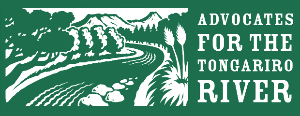Advocates’ Wilding Pine Eradication Programme
Our wilding pine programme dates back to 2005 when we became aware with a degree of horror that wilding pine growth was taking over much of the iconic native scrubland and bush along the Tongariro, particularly upstream of the State Highway 1 Bridge.
We decided that urgent action was needed and after bringing the matter to the attention of the Department of Conservation in Turangi were advised by Conservator, Paul Green, that they, too, were aware of the problem but did not have funding available to tackle it.
After giving thought to our approach we were invited to consider carrying out a programme of eradication by chemical treatment in the two DOC reserves, Waikari and Paurini. The process simply involved drilling a set number of holes in the tree trunks into which ordinary weed-killer was applied. As a volunteer group there was no issue with safety as the machinery we would use was only an auger, a mechanical drill, and the chemical was glyphosate, common weedkiller available to the public. If we were able to raise funding we could carry out this work without any Health & Safety issues.

We decided to give it a go and set about raising funds. We first received a pilot scheme grant from the Waikato Catchment Ecological Enhancement Trust of $5000 so we appointed Will Kemp, a local fishing guide who had had training in forestry with DOC, as our contractor.
The pilot project was completed successfully. It gave us sufficient background material on costings, operational detail, etc, to apply for a larger grant from the Waikato Regional Council’s Environment Initiative Fund for #36000 to tackle the main bulk of trees. We were successful – it was the largest grant they had made at the time, and with it we proceeded to treat about 5000 wilding pines, all about twenty years old.
The programme has been ongoing and after further fund-raising by us and with contributions from DOC, bringing the total to over $70,000, we have been able to treat 7000-odd trees on DOC estate plus carry out ongoing maintenance of re-growth and new juvenile trees.
The reason for chemical treatment rather than felling is because the trees gradually break down and do not destroy the very native scrub and bush we are trying to preserve. Needless to say, removal by helicopter is totally uneconomical. Certainly the dead skeletons are unsightly but they do ultimately rot down and disappear from sight.
The Wilding Pine programme is ongoing. Aerial surveys by helicopter and drone are carried out with new areas identified and regrowth dealt with. One of our big concerns now is the wilding pine and willow growth on the river flats, which are in Iwi ownership, and we are hoping to find a solution to this, with or without our involvement.
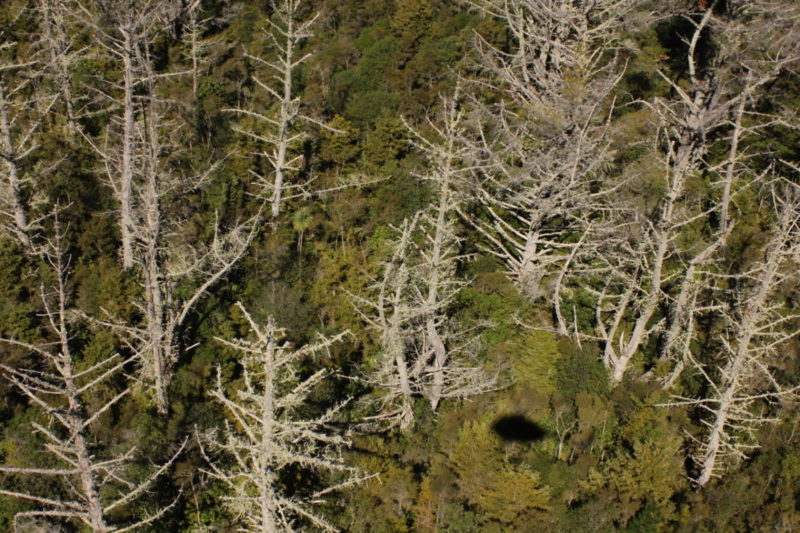

Please be assured that none of this is possible without the unique strength and support of our membership, funders and benefactors
John Toogood
June 2020
Methods of control for wilding conifers
Wilding Pines Eradication Project - Tongariro River
A Department of Conservation – Advocates Partnership
Mark Cosgrove (Past President)
Nga mihi manawhenua kaitiaki katoa
The Advocates for the Tongariro River (AFTR) envisage the Tongariro River corridor being returned as close as possible to its natural state so that the river valley’s landscape values, endemic ecology and its biodiversity status are restored.
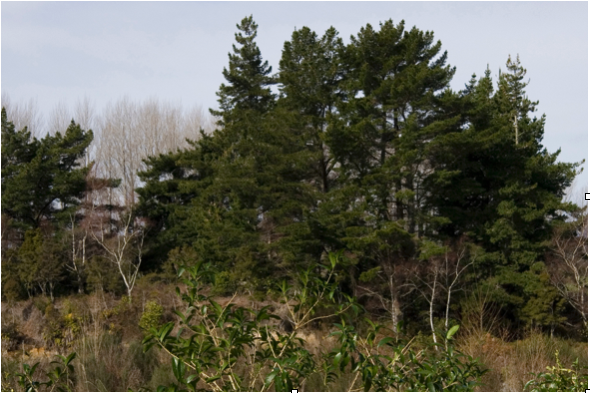
Photo 1: These young pine trees on the right bank of the Tongariro River obscure views of the Kaimanawa Ranges, and worse, they suffocate native scrub and trees, reduce the food supply and habitat for insects and birds and jeopardise bridges when swept away in floods.
In particular the AFTR recognises the river’s role as a nursery for juvenile trout is paramount to the welfare of the fishery. Young river-dwelling fish depend primarily on larval and adult insects for food. Native flora provide habitat for many insects (e.g. the manuka beetle). However few if any insects live on pine trees.
A necessary part of th AFTR’s vision is the eradication of exotic pests such as wilding pines. Pines are a particular problem because they are aggressive colonisers in New Zealand’s growing conditions (unlike their more restrained growth in their native habitats of North America).
These pines are a special nuisance in areas where native forest regrowth is being encouraged; such as alongside the Tongariro River. Pines are visually intrusive, an important factor where aesthetic landscape values are to be restored. The pest trees also overpower emerging native plants as they win the competition for forest space. For the fauna they offer none of the advantages of native trees, no berries or nectar, which encourage bird and insect life. Further, pine needles inhibit regeneration of native forest floor flora.
Nationwide there are many campaigns aimed at curtailing these pest trees. A Google search will show the vigour of the overall crusade as New Zealanders restore their respect for native flora; there are over 300 pages of websites. All Regional Councils are taking action against wilding pines as part of New Zealand’s Biodiversity Strategy. The Marlborough Sounds eradication of pines project by the community and DoC is an often quoted example of this movement and near Taupo, the Kinloch Community Association is dealing with feral pines. There are other instances easily observable south from Taupo; along State Highway 1 at Hatepe, many recently poisoned pine trees can be seen in the Hinemaiaia River Valley. The joint DoC – Tongariro Natural History Society project to restore the Motuoapa wetlands brought about the poisoning of pine trees, clearly visible from the highway.
Our campaign to eliminate pines started several years ago, with trial poisoning in the Department of Conservation reserves on the left bank of the Tongariro River upstream of the Trout Centre and later, by the AFTR, on the right bank. The work, as yet unfinished, has moved upstream to about 1 km above the Red Hut suspension bridge. The effect of the poisoning there is not subtle, there are many trees in the late brown stage, in which the needles die and drop. Soon the skeletons will turn grey and later they will rot away.
Understandably, some people are concerned at the effect of rust-brown pine needles on large trees on the skyline. Of course, if the problem had been addressed say 20 years ago when the trees were much smaller the visual effects would have been much lower, perhaps not even noticeable. And, conversely, if they were to be left any longer the capability to manage them would become far more difficult and perhaps cause the increasing persistence of a wilding pine forest. The Department of Conservation had no funding to do this work and it may well have considered that there was little community interest anyway. Even now with some funding provided through grants made to the AFTR there is just enough to support this poisoning technique.
Here are the facts underpinning the strategy this restoration project has taken
At present there are many middle-sized poisoned wilding pines causing concern. Can anything be done to improve the situation? The AFTR have explored several possible options.
Removing the skeletal trees, known as standing spurs, by cutting them down is dangerous on two counts. First there is high risk to the safety of timber workers. Secondly un-rotted spurs lying on the ground present heavy fuels which increase the risk of extreme fire damage should there be a bush fire. Further, the damage to any understorey of regenerating natives as whole spurs crash down would be disastrous. So tree skeleton removal is not an option. The standing spurs must be left to rot down.
How long might this take? Climate and weather will play a major role. From about five years the effects of rotting down should be noticeable. Wind damage also assists the breakdown.
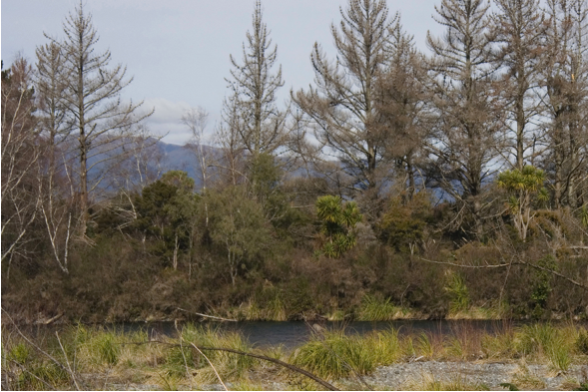
Photo 2: A resident exclaimed, “I can see the mountains now.” These poisoned trees let more light into the scrub layers. Unsightly for a time, there is no other practical way to deal with them.
This method is not only the most cost effective way of dealing with these pines, but it is also the most effective irrespective of cost.
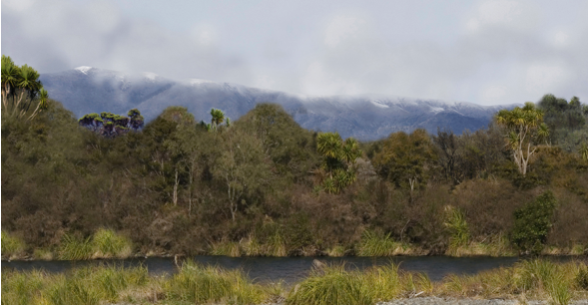
Photo 3: The pines will rot away and the river’s banks will return to their original vegetation as this photo-creation suggests. Native and endemic species such as manuka, kanuka, kowhai, toetoe and other grasses, ti rakau (cordyline spp) and flaxes will return.
The gradual shedding of needles as the trees die means that the light entering the forest floor gradually intensifies. This factor favours the survival and growth of native trees; if the whole pest tree is suddenly removed the survival of young exotic trees would be favoured.

Photo 4: Once the lower canopy is re-established, the podocarps will slowly re-appear – beech, maire, matai, totara and rimu – as shown here where there are few wilding pines.
However, as part of the partnership between DoC and AFTR it was always intended and agreed that the trees along the access tracks and river banks would be felled by contractors with funding arranged by AFTR. Accordingly there will not be any safety issues in relation to those trees (whether already poisoned or not) along any track areas, as they will shortly be felled and physically removed professionally.
Already biodiversity gains have been detected. DoC Officers report that a stand of juvenile totara in the upper river has been given a better start and should grow to maturity now that the pines there have shed their needles, thus letting light in.
The AFTR appreciate the concern at the temporary harm done to the skyline landscape in parts of the river valley. But how else could this problem be addressed? The AFTR have taken the only course available.
Why are the Advocates involved?
The AFTR regard the river as a taonga of the highest rank in this district and the Society is committed to helping the river’s recovery and eventual restoration. This commitment takes in four practical steps at present; namely:
- Protection of existing indigenous flora; mature and juvenile kahikatea of majestic status on private land at Kowhai Flat have been listed in the Taupo - District Council’s outstanding and notable trees registry. As such these specimens form a distinctive attraction to tourists. They tell another story too; given that they are centuries old they tell us how long that land has been stable and not eroded.
- Planting further specimens of endemic species, especially kowhai and flaxes, along the riverside walkway.
Weeding amongst newly planted natives, involving AFTR members, residents and occasionally Corrections Department inmates.
- Eliminating wilding pines. This part of the restoration will achieve native plant germination and re-growth through better light conditions and through improved forest floor conditions, as outlined above.
This eliminating wilding pines project so far represents the first two stages of a five-stage program to deal with wilding pines near the Tongariro River. If we were to stop now we would expect to achieve very little, so the next three stages are crucial.
Stage 3 is, first, to seek the destruction of wilding pines from government lands and private property adjoining the river. Second, the pest trees near river margins need to be removed.
Stage 4 will attempt to deal with juvenile wilding pines. This stage will have to be community based and persistent. Just as we have adopted and responded to the Biosecurity mantra, “Check, Clean, Dry” for didymo prevention a similar refrain for Tongariro River anglers, to “Pull out a pine tree today” will greatly assist this ecological restoration project.
Stage 5 is a monitoring and research project with scientific observation of treated areas to measure the effectiveness off the whole project. Already there are reports of positive signs of regenerating native flora.
The AFTR has received funding from several sources. These include Trustpower Awards, and grants from the Waikato Catchment Ecological Enhancement Trust, the Pharazyn Trust and the Waikato Regional Council. These bodies would not have committed their funds for these projects if they had not been sure of the quality of the applications mounted by the AFTR, the degree of accountability shown and the society’s growing track record of getting ecologically important things done.
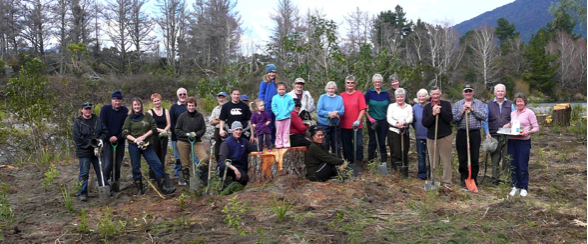
Photo 5: Planting day, 22 August 2009. This group planted some 1,000 native shrubs and trees on a portion of the riverbank near Taupahi Reserve
The AFTR has received a number of awards for its ecological work. These include the TrustPower Community Award for the environment, and from the Tongariro Taupo Conservancy of the Department of Conservation, an award which recognises the work done towards the conservation of the natural, historic and cultural resources of the Central North Island.
Further activity involving other plant pests and catchment management is in the pipeline. Members of the AFTR have suggested that other plant pests be confronted; Scotch broom and blackberry are often mentioned.
The AFTR work within the guidelines of New Zealand’s Biodiversity Policy and it co-operates with the Department of Conservation in this task of controlling exotic pest species so that native flora and fauna may survive.
Many of the members of the AFTR are residents, or are frequent visitors to Turangi and most are enthusiastic anglers. We, like everyone else, share this amazing river and are keen to preserve its heritage and quality not only for our own enjoyment but for future generations. The steps that have been taken in conjunction with DoC are in the long term interests of the river itself.

Photo 6: Weeding group, Easter Saturday 2010. Seven months after planting these plants have survived the summer dry and with continued care should soon grow above the weeds.
We warmly welcome the involvement of others committed to the preservation and enhancement of the river, and refer you to our website below if you would like to find out more about AFTR.
For more information about wilding pines enter these websites:
wildernessmag.co.nz
or Google ‘wilding pines nz’
The AFTR website is www.tongariroriver.org.nz
The writer acknowledges John Toogood’s ideas in formulating this project and his 2009 report to the Advocates’ membership.
John Grose assisted with the graphics in this article and his help is gratefully acknowledged.
Reviewed March 2023
